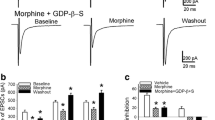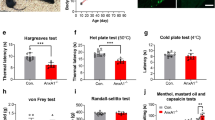Abstract
1. ω-CgTx attenuated formalin-evoked biphasic flinches, while PKC inhibitor (STU) attenuated phase 2 and was reversed by PDBu.
2. ω-CgTx and STU suppressed the increase in CSF-glutamate after formalin injection.
3. Morphine completely suppressed both increased flinching and CSF glutamate release.
4. Thus, ω-CgTx (N-type Ca channels) may regulate neurotransmitter release evoked by C fiber activation and the formalin-evoked hyperalgesia may possibly be provoked as a result of PKC activation elicited by both presynaptic neurotransmitter release and activation of NMDA receptors in the spinal neurons.
Similar content being viewed by others
REFERENCES
Bliss, T. V. P., and Collingrige, G. L. (1993). A synaptic model of memory—Long-term potentiation in the hippocampus by phorobol esters. Nature 361:31–39.
Cahill, C. M., White, T. D., and Sawvnok, J. (1993). Morphine activates ω-conotoxin-sensitive Ca2+ channels to release adenosine from spinal cord synaptosomes. J. Neurochem. 60:894–901.
Chen, L., and Huang, L. Y. M. (1992). Protein kinase C reduces Mg2+ block of NMDA-receptor channels as a mechanism of modulation. Nature 356:521–523.
Coderre, T. J. (1992). Contribution of protein kinase C to central sensitization and persistent pain following tissue injury. Neurosci. Lett. 140:181–184.
Coderre, T. J., Katz, J., Vaccarino, A. L., and Melzack, R. (1993). Contribution of central neuroplasticity to pathological pain: Review of clinical and experimental evidence. Pain 52:259–285.
Dickenson, A. H., and Sullivan, A. F. (1987). Subcutaneous formalin-induced activity of dorsal horn neurons in the rat—differential response to an intrathecal opiate administered pre or post formalin. Pain 30:349–360.
Gandhi, V. C., and Jones, D. J. (1992). Protein kinase C modulates the release of [3H]5-hydroxytryptamine in the spinal cord of the rat—The role of L-type voltage-dependent calcium channels. Neuropharmacology 31:1101–1109.
Kavaliers, M., Ossenkopp, K. P., and Tysdale, D. M. (1991). Evidence for the involvement of protein kinase C in the modulation of morphine-induced “analgesia” and the inhibitory effects of exposure to 60-Hz magnetic fields in the snail, Cepaea nemoralis. Brain Res. 554:65–71.
Maggi, C. A., Tramontana, M., Cecconi, R., and Santicioli, P. (1990). Neurochemical evidence for in the involvement of N-type calcium channels in guinea pigs. Neurosci. Lett. 114:203–206.
Malmberg, A. B., and Yaksh, T. L. (1993). Pharmacology of the spinal action of ketrolac, morphine, ST-91, U50488H, and L-PIA on the formalin test and in isobolographic analysis of the NSAID interaction. Anesthesiology 79:270–281.
Malmberg, A. B., and Yaksh, T. L. (1994). Voltage-sensitive calcium channels in spinal nociceptive processing: blockade of N-and P-type channels inhibits formalin-induced nociception. J. Neurosci. 14:4882–4890.
Mao, J., Price, D. D., Mayer, D. J., and Hayes, R. L. (1992). Pain-related increases in spinal cord membrane-bound protein kinase C following peripheral nerve injury. Brain Res. 588:144–149.
Marsala, M., Malmberg, A. B., and Yaksh, T. L. (1995). The spinal loop dialysis catheter: Characterization of use in the unanesthetized rat. J. Neurosci. Methods 62:43–53.
Murray, C. W., Cowan, A., and Larsaon, A. A. (1991). Neurokinin and NMDA antagonists (but not a kainic acid antagonist) are antinociceptive in the mouse formalin model. Pain 44:179–185.
Ocana, M., and Baeyens, J. M. (1995). Analgesic effects of centrally administered aminoglycoside antibiotics in mice. Neurosci. Lett. 126:67–70.
Smith, F. L., and Stevens, D. L. (1995). Calcium modulation of morphine analgesia: Role of calcium channels and intracellular pool calcium. J. Pharmacol. Exp. Ther. 272:290–299.
Sorkin, L. S. (1993). NMDA evokes an L-NAME sensitive spinal release of glutamate and citrulline. Neuroreport 4:479–482.
Yaksh, T. L., and Rudy, T. A. (1976). Chronic catheterization of the spinal subarachnoid space. Physiol. Behav. 17:1031–1036.
Zhang, L. J., Wang, X. J., and Han, J. S. (1990). Phorbol ester suppression of opioid analgesia in rats. Life Sci. 47:1775–1782.
Author information
Authors and Affiliations
Corresponding author
Rights and permissions
About this article
Cite this article
Nakanishi, O., Ishikawa, T. & Imamura, Y. Modulation of Formalin-Evoked Hyperalgesia by Intrathecal N-Type Ca Channel and Protein Kinase C Inhibitor in the Rat. Cell Mol Neurobiol 19, 191–197 (1999). https://doi.org/10.1023/A:1006937209676
Issue Date:
DOI: https://doi.org/10.1023/A:1006937209676




